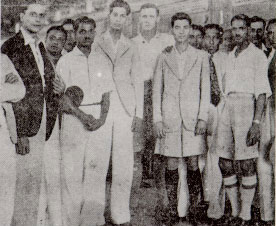The World's Hockey Champions 1936
By Olympic Gold Medallist M. N. Masood
|
Page 1 |
Page 2 |
Page 3 |









 |
Page 4 |
Page 5 |
Page 6 |
Inter-Provincial
Championship
| Bengal and Manavadar contested in the final
for the honour of victory, and for the Maori Shield presented to the Indian team that toured
New Zealand in 1935.
Bengal was a comparatively fresh side as it had
3 days of rest, while Manavadar was playing its 4th consecutive game.
A lucky goal scored in the last minute gave Bengal victory, the
shield and the title.
|
|
Page 7 |
Page 8 |
Page 9 |
Page 10 |
Page 11 |
Page 12 |
 he
Bengal Hockey Association and the Madras Hockey Association sent out proposals
to hold the 1936 Inter-Provincial Hockey Tournament in their respective centres.
The Indian Hockey Federation decided to hold the tournament at Calcutta.
he
Bengal Hockey Association and the Madras Hockey Association sent out proposals
to hold the 1936 Inter-Provincial Hockey Tournament in their respective centres.
The Indian Hockey Federation decided to hold the tournament at Calcutta.
Thirteen affiliated associations communicated their intention to participate
in this great event of Indian hockey, the notable absentee being the Gwalior
Association. Each provincial association held inter-district or inter-divisional
tournaments or trials in its centre before it picked its provincial side. The
tournament was held during the first and second weeks of March 1936.
Calcutta was wisely selected as the venue of Inter-Provincial matches. It has
grounds on which it is a treat to play, it has a vast sporting crowd in its huge
population, and it has selfless workers like Mr. Pankaj Gupta who know how to
run a tournament economically and successfully.
Boarding and lodging arrangements for about two hundred players and their
officials were made by the Bengal Hockey Association. Mr. Pankaj Gupta, its
Honorary Secretary, attended personally to every little detail. He was always
handy, dressed in his usual 'dhoti' and with 'paan' in his mouth,
to give whatever aid the competitors needed.
Forecasts about the results of the matches and the ultimate personnel of the
Olympic team were not few, and the sporting atmosphere of Calcutta was laden
with rumours of all sorts. An experienced player would, however, not care about
the forecasts; nor would the rumours, adverse or favourable, affect him. He
would instead stick to the work before him; that of putting one's best in the
playing field.
Manavadar in the final
High hopes were centred on the Punjab team, winner of the last
Inter-Provincial tournament. Bhopal, a new-comer and an unknown quantity, was
its first opponent. It came therefore as a surprise when the freshmen extended
the defending champions, who just managed to draw the game. No goal was scored
by either side.
Punjab would win easily the next day, it was thought. Its players might
not have touched their form this day, and these things do happen with players in
any competition. But Bhopal beat Punjab the next day 1-0! This was the first
surprise of the tournament, and a big one at that.
Meanwhile, Bombay met United Provinces (UP) and made an easy work of the
match, winning 3-2. Both sides were considered strong, but UP disappointed
its supporters. Except for Roop Singh who did some good work, no player could
come up to a provincial standard.
Bombay now met Bhopal. The latter justified the high hopes placed in it, and
played Bombay to a 1-1 draw. It was thought that Bhopal would win the replay
against Bombay, as it did against Punjab.
But the drawn games had adversely affected the endurance of the Bhopal
players, and they took the field a tired side against Bombay the next day. They
played pluckily, but their captain, Ahsan Mohammad Khan, hurt himself after
resumption and left the field. Bhopal lost to Bombay by a love goal. The latter
side was now the favourite for the Cup.
Manavadar played against Sind and won 2-1. Both sides had good reputations
behind them, but the former was acknowledged as the superior side. A win for
Manavadar was, therefore, expected.
Manavadar now met Bombay. This match had to be played three times before
Manavadar came out victorious 4-1. Its combined play was its strength, and
Bombay could not stand it on the third day, after the results were 0-0 on the first
day and 1-1 in the replay.
Bengal in the final
Bengal met Bihar and Orissa (B & O) in its first encounter and won
comfortably 7-0; the B & O side was perhaps the weakest in the competition.
Railways, Bengal's next opponents, were not fully represented and were therefore
no match to a strong side like Bengal. They went down fighting by 3 love goals.
Meanwhile, Delhi beat Central India in its first match 2-1, and then played a
goalless draw against Madras. In the next day's replay, extra-time decided the
fate of Madras, whose lack of stamina in its players was the weak point.
Madras lost 3-4 after an uninteresting game.
Delhi now met Bengal, and as expected, lost to it by 3 love goals.
Inter-Provincial final
Bengal and Manavadar contested in the final for the honour of victory, and
for the
Maori Shield presented by the Maoris of New Zealand to the Indian team that
toured their country in 1935. Bengal was a comparatively fresh side as it had
three days rest, while Manavadar was playing its fourth consecutive game.
Manavadar was superior to Bengal in the first half of the game, but after
resumption, the latter had the better of the exchanges. A lucky goal scored in
the last minute of the match gave Bengal victory, the shield and the
championship.


Indian team that toured
NZ and Australia. Author is on extreme left

